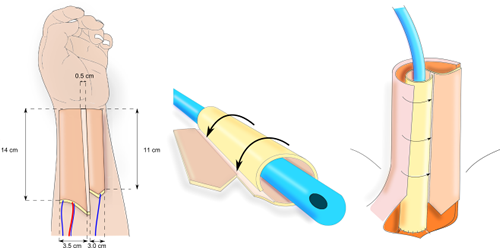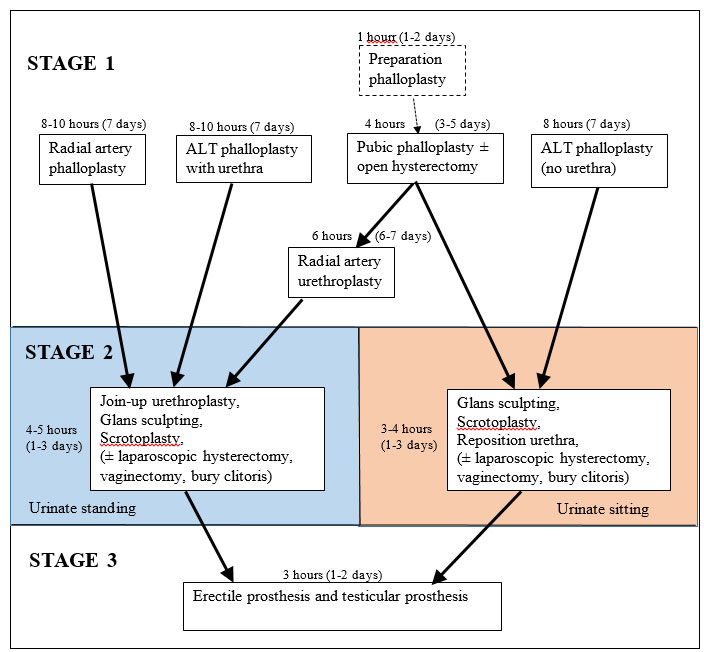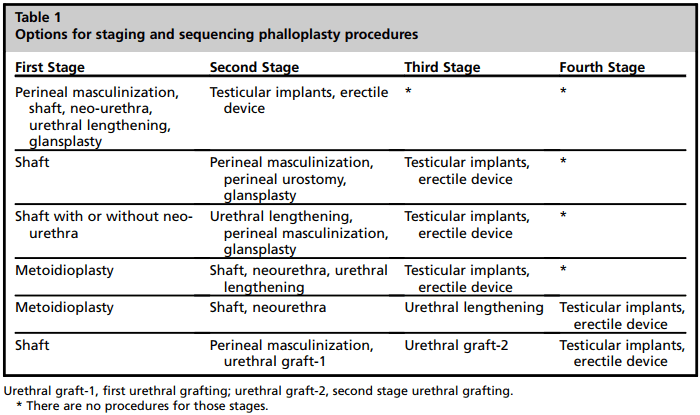Phalloplasty Staging: What to Expect and Why It Matters
Just as there are several different Phalloplasty techniques, there are also multiple ways the surgery can be staged over time. Understanding how and why staging varies is an important part of choosing a surgeon and preparing for your surgical journey. This article explores the various staging approaches used by Phalloplasty surgeons and what they mean for patients.
1-Stage Tube-Within-Tube
The most commonly understood way of staging Phalloplasty surgery is the so-called “1-stage” tube-within-tube design of the Radial Forearm Flap Phalloplasty (RFF). In this approach, both the phallus and full-length urethra are created in a single surgery—hence the term “1-stage.” However, additional procedures are typically required, so the entire phalloplasty process still involves multiple stages overall. Developed in the early '80s, the primary advance of this design was the creation of a vascularized urethra incorporated into the phallus (a tube-within-tube) in one operation. Previous efforts created the urethra with a skin graft or prefabricated with a multistaged tubed pedicle flap, which invariably led to increased urethral complications.1

This approach typically includes vaginectomy, creation of the phallus with a full urethra, scrotoplasty and glansplasty in Stage 1. The second stage surgery usually occurs anywhere from 6 to 12 months later and includes insertion of testicular and erectile prosthetics. While additional stages are sometimes required for aesthetic improvements (liposuction, fat grafting, mons resection, etc.) or functional repairs, a benefit of this approach is that the surgery can often be completed in just two operative events. In terms of financing and scheduling surgery, this is a major advantage for patients.
Some surgeons offer Integra to their patients to improve the appearance of the flap donor site. Integra helps close the forearm wound faster and with less contraction. If Integra is used, an additional stage is added 2-3 weeks following Stage 1 to replace the Integra with a skin graft.
Expert Note:
"The single-stage versus 2-stage approach refers specifically to the 2 parts of the urethroplasty. This is a topic of debate among experts in the field.6–8 The crux of the decision to stage or not to stage is whether creation of the perineal urethra and the shaft urethra should happen at the same time or at 2 time points. Another area of debate is whether the urethra should be constructed with vascularized or grafted tissue." —Staging in Phalloplasty. Sara Danker, Nick Esmonde, Jens Urs Berli.Multi-Stage Phalloplasty
While some patients are candidates for a single-stage tube-within-a-tube phalloplasty, many surgeons now prefer a multi-stage approach, particularly to improve urethral outcomes and flap vascularity. Staging phalloplasty can also give patients flexibility to consider additional procedures like vaginectomy or clitoral burying between stages.
Two-Stage Urethroplasty
To reduce urethral complications like fistulas and strictures, many surgeons now perform urethral reconstruction in two stages. This approach is used with both RFF (radial forearm flap) and ALT (anterolateral thigh) phalloplasties. Two common variations include:
 Phallus-First Approach:
Phallus-First Approach:
In Stage 1, the phallus is created complete with a urethra. Then, in Stage 2 (about 6 months later), the newly constructed urethra is connected to the native urethra and vaginectomy is performed. This is the standard approach used by Dr. Jens Berli and the surgical team at the OHSU Transgender Health Program. Their method, called Big Ben, was developed by the phalloplasty team in London, UK.
WATCH: Big Ben Phalloplasty Step by Step Video- Metoidioplasty-First Approach:
In Stage 1, a procedure similar to metoidioplasty is performed along with vaginectomy, extending the native urethra by a few inches. Then, in Stage 2 (several months later), the urethra is extended to the tip of the phallus, completing the connection.2
Both approaches aim to separate complex urethral reconstruction into manageable stages, reducing the risk of multiple simultaneous complications and improving overall outcomes and patient quality of life.
Staged ALT Phalloplasty
While one-stage tube-within-a-tube ALT Phalloplasty is appropriate for some patients, it’s not always feasible. For instance, if the ALT flap has too much subcutaneous fat, the tube-within-a-tube design can't be performed. In such cases, surgeons may recommend additional staging to enable urethroplasty or improve flap vascularity.
One option is non-vascularized urethroplasty, which uses grafts such as buccal mucosa, vaginal mucosa, or skin to construct the urethra in a separate stage. However, this technique is less commonly used today due to its higher rates of complications like fistulas and strictures.
 Another approach is the Delayed ALT Flap, developed by Dr. Curtis Crane. This method involves surgically “delaying” the ALT flap by elevating it, interrupting its secondary blood supply while preserving the main artery, and then suturing it back in place during Stage 1. After the flap’s vascularity improves over time, phallus creation takes place in Stage 2. This approach can be beneficial for patients with borderline blood supply to the ALT flap, though it does add an extra surgical stage. Learn more about Delayed ALT Flap Phalloplasty.
Another approach is the Delayed ALT Flap, developed by Dr. Curtis Crane. This method involves surgically “delaying” the ALT flap by elevating it, interrupting its secondary blood supply while preserving the main artery, and then suturing it back in place during Stage 1. After the flap’s vascularity improves over time, phallus creation takes place in Stage 2. This approach can be beneficial for patients with borderline blood supply to the ALT flap, though it does add an extra surgical stage. Learn more about Delayed ALT Flap Phalloplasty.
Staging Examples
Surgeons may stage phalloplasty differently depending on patient anatomy, surgical goals, and preferred techniques. The following examples illustrate three common staging approaches, highlighting the sequence and timing of procedures like hysterectomy, urethral lengthening, phallus creation, and implant placement.
View Example A Staging
Stage 0: Hysterectomy.
Wait 3+ months to provide time to heal.
Stage 1: Phalloplasty penis-creation, urethral lengthening.
Wait 3–6 months to provide time to heal.
Stage 2: Urethral hookup, scrotoplasty, erectile body burial, and closure of the vagina.
Wait 4–6 months to provide time to heal.
Stage 3: Insertion of an erectile device and/or testicular implant(s).
View Example B Staging
Stage 0: Hysterectomy.
Wait 3–6 months to provide time to heal.
Stage 1: Phalloplasty penis-creation.
Wait 3–6 months to provide time to heal.
Stage 2: First stage of urethral lengthening, scrotoplasty, and closure of the vagina.
Wait 3–6 months to provide time to heal.
Stage 3: Second stage of urethral lengthening, urethral hookup, and glansplasty.
Wait 4–6 months to provide time to heal.
Stage 4: Insertion of an erectile device and/or testicular implant(s).
View Example C Staging
Stage 0: Hysterectomy.
Wait 3+ months to provide time to heal.
Stage 1: Metoidioplasty, urethral lengthening to the tip of the erectile body, closure of the vagina.
Wait 3–6 months to provide time to heal.
Stage 2: Phalloplasty penis-creation, urethral lengthening through the phalloplasty-created penis.
Wait 4–6 months to provide time to heal.
Stage 3: Urethral hookup, scrotoplasty, clitoral burial.
Wait 4–6 months to provide time to heal.
Stage 4: Insertion of an erectile device and testicular implants.

How the surgeons at the St. Peter's Andrology Centre in London stage Phalloplasty. Source: andrology.co.uk

Source: Staging in Phalloplasty. Danker et al.
Prefabrication and Prelamination of the Urethra
Additionally, there are surgeons who offer prefabrication or prelamination of the urethra using either a full or split thickness skin graft, which adds a stage before creation of the phallus. However, some surgeons believe the indications for urethral reconstruction in this manner should be limited to cases for which no other option is suitable.3
Prelamination with mucosal grafts also has been reported as a possible method of reducing urethral complications but more investigation is needed.4 Dr. Christopher Salgado uses the prelamination technique with mucosal grafts from the inside of the cheeks and/or vagina, wrapping them around a catheter and placing the structure under an elevated forearm flap.5 This is left in place until the tissues are transferred to the groin in stage 2.
WATCH: Patient of Dr. Salgado's explains aftercare for prelaminated urethra.
The Impact of Staging on Recovery and Life Planning
Staging phalloplasty surgery affects not only the physical healing process but also the emotional and practical aspects of a patient’s life. Multiple surgeries spaced over months or even years mean patients must prepare for several recovery periods, each with its own healing timeline, restrictions on activity, and follow-up care. This can require taking extended or repeated time off work or school, arranging travel to and from the surgical center, and coordinating care and support at home. This requires careful financial planning and the need to balance surgery with other life commitments.
Emotionally, the staged approach can bring both challenges and benefits. The longer overall timeline may feel overwhelming and stressful, with periods of uncertainty between surgeries. On the other hand, staging allows patients time to adjust physically and emotionally after each phase, potentially reducing the intensity of recovery and complication risks. It also provides opportunities to reflect on results, ask questions, and make decisions about additional procedures. Understanding these impacts is crucial for patients and their support networks to prepare realistically for the phalloplasty journey.
As more research is done into ways of improving Phalloplasty outcomes, the different ways of staging Phalloplasty will likely continue to evolve. Currently, surgeons offer a number of different approaches to staging—some complete the phallus and urethra in a single surgery, while others delay creation of the urethra or even the phallus itself across multiple stages. Each approach has trade-offs in terms of surgical complexity, complication risk, recovery time, and number of operations. For those planning to undergo phalloplasty, understanding these differences is key to setting expectations, selecting a surgical team, and planning the surgical journey.
Related Studies
Long-term Urologic Outcomes Using the Big Ben Method for Phalloplasty
Berli JU, Ferrin PC, Buuck C, Cylinder I, Putnam C, Dy GW, Peters BR, Llado-Farrulla M, Sajadi KP, Annen A. Plast Reconstr Surg. 2025 May 7. Epub ahead of print.
This study looked at the long-term results of the two-stage “Big Ben Method,” used by Dr. Berli between 2016 and 2023. This staged procedure involves creating the penis first, with the urethra not connected until the second surgery several months later. Among 73 patients with at least six months of follow-up, 96% were able to urinate while standing after the second surgery. The overall rate of urinary complications was 27%, with 8% experiencing a urethral stricture (narrowing) and 16.4% developing a urethro-cutaneous fistula (an unwanted opening). Overall, the Big Ben Method shows promise in reducing certain complications and helping patients achieve standing urination.
Staged phalloplasty in gender-affirming surgery has lower rates of postoperative complications.
Green J, Swiekatowski K, Slaughter K, Howell S, Freet D. Presented at: Plastic Surgery The Meeting 2023; October 29, 2023; Austin, TX. Abstract 38770.
Staging hysterectomy, urethroplasty, and phalloplasty for gender-affirming surgery in transgender men appears to provide clear benefits. Staged procedures have better surgical outcomes as evidenced by a decrease in overall complication rates, urethro-cutaneous fistula rates, and reoperation rates. Although single procedures may be preferred for patients traveling long distances, their increased rates of complications necessitate frequent reoperations, attenuating their potential benefits. Larger, multi-institutional studies are needed to better understand the differences in complications from single and staged procedures.
Staged
Phalloplasty by Metoidioplasty First Does Not Appear to Lower
Complication Rates
Mieke Waterschoot, Piet Hoebeke, Wesley Verla, Anne-Françoise
Spinoit, Stan Monstrey, Marlon Buncamper and Nicolaas Lumen. 7 Jun
2023. Transgender Health.
Some patients opt to undergo staged phalloplasty by metoidioplasty
first (SPMF). The aim of this study was to evaluate whether SPMF
is associated with less surgical complications compared with
immediate phalloplasty (IP). In our cohort, complications were not
reduced by SPMF. In case metoidioplasty is considered as a step
toward phalloplasty, separate morbidity of metoidioplasty must be
taken into account.
The
Montréal Classification of urethral lengthening for phalloplasty
in transmasculine patients-surgical techniques and urethral
complications. [FULL TEXT]
Bonapace-Potvin M, Lorange E, Ma X, Medor MC, Bensimon É, Brassard
P, Bélanger M. Int J Transgender Health. 2022 Aug
9;24(4):461-468.
In this study, post-operative urological complications for
immediate anastomosis versus two-stage anastomosis were reported
in 77.7% and 18.2% of patients, respectively. Over the last few
years, the Montreal team has shifted away from single-stage
anastomosis and has adopted a two-stage anastomosis technique.
A systematic review of staging and flap choice in gender-affirming phalloplasty. [FULL TEXT PDF]
Wu CA, Jolly D, Boskey ER, Ganor O. J Reconstr Microsurg Open. 2022;7:e13–e26.
Neourethra
Creation in Gender Phalloplasty: Differences in Techniques and
Staging
Berli JU, Monstrey S, Safa B, Chen
M. Plast Reconstr Surg. 2021 May
1;147(5):801e-811e.
Neourethra reconstruction is the most challenging aspect of
phalloplasty, with widely varying techniques and staging
between providers. In this expert opinion article, the authors
strive to give an overview of the principles behind, and a
detailed explanation of, the technical details of creating the
penile and bulbar urethra during phalloplasty. The authors focus
on the three most common strategies: single-stage phalloplasty;
two-stage phalloplasty with a metoidioplasty-first approach; and
two-stage phalloplasty with a phalloplasty-first (Big Ben method)
approach. It is not the authors' intent to establish the "best" or
"only" way, but rather to compile different options with their
respective pros and cons.
Single
versus two-stage phalloplasty for transgender female-to-male
patients: a systematic review of the literature. [FULL
TEXT]
Huayllani MT, Boczar D, Saleem HY, Cinotto G, Avila FR, Manrique
OJ, Ciudad P, Rinker BD, Forte AJ. Ann Transl Med.
2021 Apr;9(7):608.
In this study, two-stage phalloplasty had greater rate of
complications such as urethrocutaneous fistulas and total/partial
flap necrosis when compared to a single-stage phalloplasty.
References:
1. Gottlieb LJ. Radial Forearm. Clin Plast Surg. 2018 Jul;45(3):391-398.
2. Gottlieb.
3. Monstrey SJ, D'Arpa S, Colebunders B, Lumen N, Hoebeke P. Anterolateral Thigh Flap Phalloplasty in Gender Affirmation: Medical and Surgical Perspectives (Thieme, Dec 1, 2016.)
4. Salgado CJ, Fein LA, Chim J, Medina CA, Demaso S, Gomez C. Prelamination of Neourethra with Uterine Mucosa in Radial Forearm Osteocutaneous Free Flap Phalloplasty in the Female-to-Male Transgender Patient. Case Reports in Urology, Volume 2016.
5. Christopher J. Salgado MD, Ajani Nugent MD, Josef Hadeed MD,
Maria Lalama BS, Jorge Rey MD & Carlos Medina MD. Two-Stage Prelaminated Mucosal Neourethra
Radial Forearm Flap Phalloplasty for Transgender Men [FULL
TEXT]
Global Journal of Medical Research: I Surgeries and
Cardiovascular System, Volume 21, Issue 1, 2021.
6. Sara Danker, Nick Esmonde, Jens Urs Berli. Staging in Phalloplasty. Urol Clin North Am. 2019 Nov;46(4):581-590.
Last updated: 06/22/25
